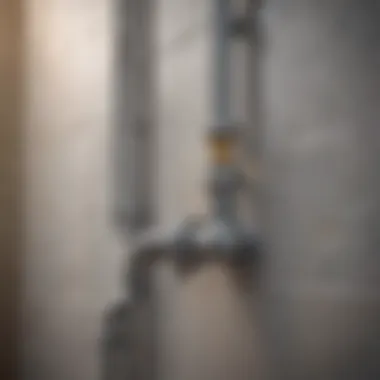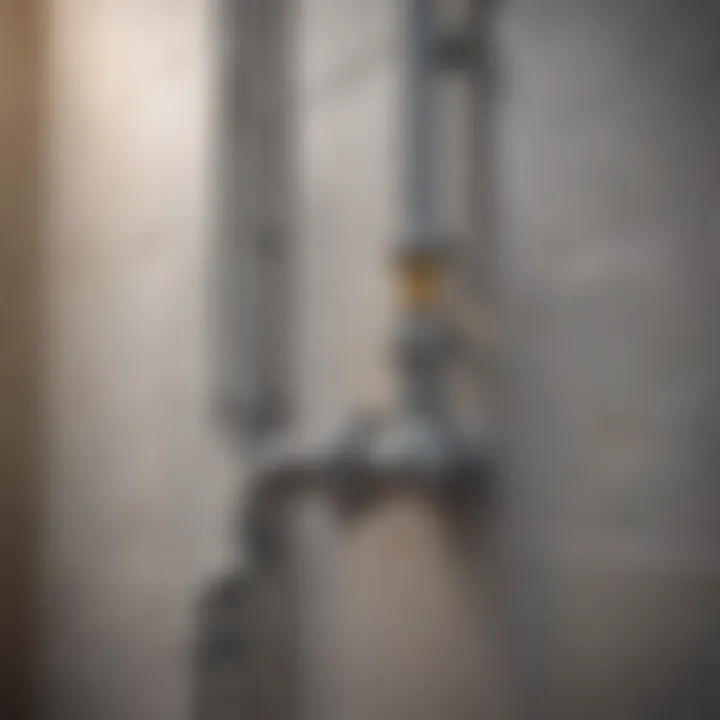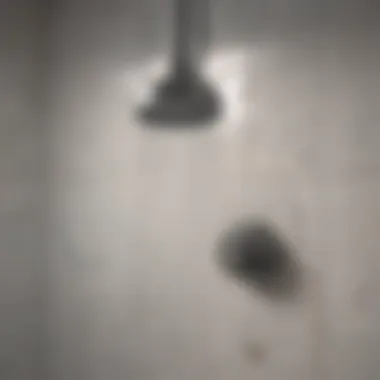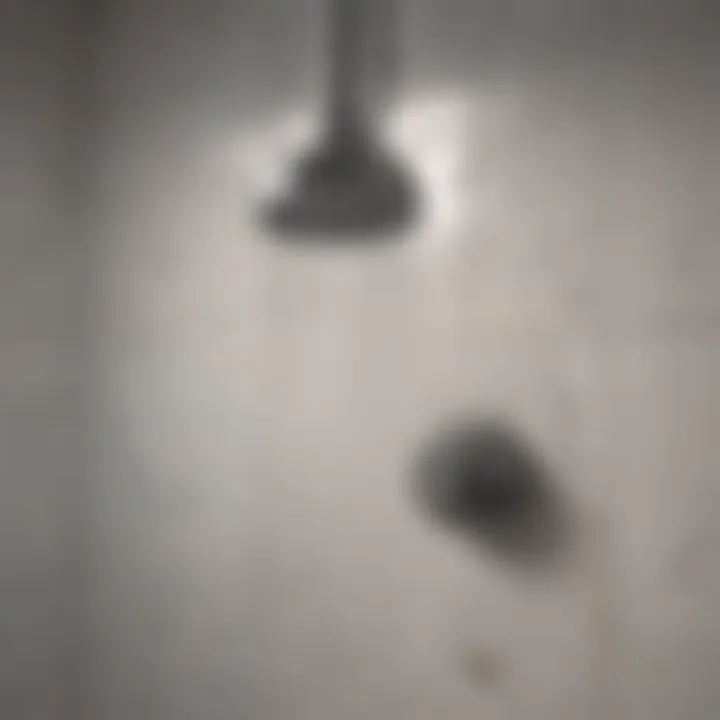Understanding and Addressing Slow Draining Showers


Intro
Slow draining showers are not only a nuisance but can also indicate underlying plumbing issues. Homeowners and design enthusiasts alike should understand how this problem unfolds, why it occurs, and what actions can be taken. The water not draining efficiently interferes with the bathing experience and may lead to further complications if left unattended. This article will guide you through the causes, risks, and practical solutions related to slow draining showers, enhancing your knowledge about shower systems and plumbing maintenance.
Causes of Slow Draining Showers
To properly address slow draining showers, it is essential to first pinpoint the reasons behind the issue. Common causes include:
- Clogged Drains: Hair, soap scum, and other debris can build up in the drain over time, restricting water flow.
- Shower Head Design: Some shower heads have flow restrictors to save water. If these get clogged, water drainage can slow down.
- Poor Pipe Design: Improperly designed plumbing can misdirect water flows or lead to blockages.
- Grease Buildup: In homes with multiple bathrooms sharing a drain system, grease buildup can occur, impacting drainage across multiple shower units.
Potential Risks
Ignoring slow drainage can pose several risks, which encompass both plumbing and structural concerns:
- Water Damage: Prolonged standing water can rot shower floors and damage underlying structures.
- Mold Growth: Moist environments can foster mold and mildew growth, which can adversely affect health.
- Increased Repair Costs: More severe plumbing issues may arise if drainage problems are not fixed, leading to costly repairs.
Solutions for Improvement
Addressing slow draining showers requires a systematic approach. Here are some effective solutions:
- Regular Cleaning: Periodically clean drain covers and remove hair or debris to prevent clogs.
- Chemical Cleaners: Use enzymatic or chemical drain cleaners judiciously to dissolve buildup without damaging pipes.
- Install a Barrier: Consider using a drain cover to capture hair and debris before it enters the plumbing system.
- Professional Inspection: Hire a plumber to assess the system's design and identify issues like incorrect pipe slopes or poor venting.
Culmination
Understanding slow draining showers involves recognizing the contributing factors, potential risks, and practical solutions. By acting proactively and implementing maintenance practices, homeowners can ensure their showers drain efficiently. This knowledge not only enhances comfort but also protects the integrity of plumbing systems, allowing for a seamless and enjoyable bathing experience.
Prelims to Slow Draining Showers
Slow draining showers can be more than just a minor inconvenience; they can signify deeper issues within plumbing systems. Understanding this topic is crucial for homeowners who want to maintain their property's value and ensure a pleasant living environment. This section will examine the concept of slow draining, highlight its significance, and discuss potential consequences if left unaddressed.
Defining Slow Draining
Slow draining occurs when water in the shower takes longer than usual to disappear down the drain. This can create pools of water on the shower floor, which may pose a risk of slips or falls. Many may assume slow drain is due to simple clogs, perhaps from hair or soap, but the causes can be more intricate. Identifying what slow draining means in your particular context can guide effective solutions.
Importance of Efficient Water Drainage
Efficient water drainage is essential for several reasons. First, it directly affects comfort. Standing water during a shower can detract from the overall experience and may even lead to an urge to shorten showers, thus affecting personal hygiene. Second, neglecting slow drains can lead to more serious plumbing issues, such as corrosion in pipes or mold growth in damp areas. If water does not drain properly, it can also cause unpleasant odors as stagnant water develops bacteria.
An efficient drainage system not only enhances comfort but also prevents potential risks like water damage or mold infestation.
Maintaining effective draining systems means investing time and resources into understanding and managing the causes of slow draining showers. Such knowledge empowers homeowners to make informed decisions, ranging from simple DIY fixes to enlisting the help of professionals.
Common Causes of Slow Draining Showers
Recognizing the common causes of slow draining showers is essential for any homeowner or designer interested in maintaining both functionality and aesthetics in a bathroom. Each cause can lead to a series of complications if left unaddressed. Awareness of these factors helps to preserve the overall plumbing health of a household, ensuring a smoother and more pleasant shower experience. Without understanding the core issues, one may settle for mere temporary fixes that do not resolve the underlying problems. This section delves into the specifics that lead to slow drainage, facilitating the identification and rectification of these issues.
Clogged Drainage Systems
Hair and Soap Build-Up
Hair and soap build-up is a prevalent cause of slow drainage in showers. It can accumulate quietly over time, creating a significant blockage. This build-up occurs because hair strands and soap residue bind together, forming a dense material that hinders water flow. One key aspect of this issue is the accessibility. It can easily be prevented or managed with regular cleaning practices. The unique characteristic of hair and soap build-up is its gradual nature.
Regular maintenance can minimize its impact, making it a beneficial consideration in this article. Ignoring hair and soap build-up can result in more serious drainage issues down the line, necessitating extensive repairs.
Mineral Deposits
Mineral deposits, often from hard water, are another contributor to slow draining showers. As water flows through pipes, minerals like calcium and magnesium can settle and crystallize within the drainage system. This is particularly problematic as it can lead to narrowing pipes over time. The key characteristic of mineral deposits is their accumulation, which can happen unnoticed and gradually restrict flow. Their presence represents a common yet preventable cause of drainage problems.
The advantage of addressing mineral deposits early on cannot be overstated; routine descaling products can help maintain clear pipes and enhance overall drainage efficiency in showers.


Pipe Damage or Blockage
Corrosion
Corrosion is a significant factor in pipe integrity and drainage effectiveness. Over time, pipes can corrode due to various factors, including chemical reactions within the water, leading to rusty deposits. This not only reduces the diameter of the pipelines but can also create blockages. The key characteristic of corrosion is its insidious nature; it often occurs over many years without noticeable signs until the damage becomes severe.
Proper awareness of corroded pipes is valuable to homeowners, as it can facilitate timely inspections and repairs. Ignoring corrosion leads to further deterioration, ultimately increasing replacement costs.
Tree Root Infiltration
Tree root infiltration is a less commonly discussed cause but can be quite impactful. Roots can penetrate underground pipes seeking moisture, causing displacement and blockage. Trees close to homes are most at risk, often creating a significant problem as the roots expand. The unique feature of this issue is its dependency on the proximity of vegetation to plumbing systems.
This problem requires vigilance in landscaping and plumbing planning. Costly repairs can arise if the roots are not managed correctly, underlining the need for awareness in both plumbing and garden design.
Improper Drain Slope
Improper drain slope is crucial to the functioning of a drainage system. When drains are not angled correctly, water may not flow efficiently, leading to pooling. This situation can manifest from original construction errors or settling over time. Recognizing the importance of proper grading is essential in preventing slow drainage issues. Homeowners should routinely check and ensure that their showers are draining properly, tackling slope issues promptly to maintain effective plumbing systems.
Faulty Shower Components
Showerhead Issues
Showerhead issues can also contribute to slow drainage. A malfunctioning showerhead may create inconsistent water flow, affecting how water drains. The key characteristic of this issue is its noticeable impact during use, as a sluggish showerhead can diminish the overall shower experience. Addressing showerhead problems is relatively simple, making it a practical point of consideration for this article. Regular checks can help maintain a strong and steady flow, preventing further drainage complications down the line.
Division in Drain Assembly
Division in drain assembly can cause water to drain inefficiently. Components within the drain can wear out or misalign, creating gaps that lead to leaks or slow drainage. Understanding the unique feature of this division is crucial for effective repair and maintenance. Regular inspections can ensure that the assembly functions as intended, preventing potential flow issues from occurring. Neglecting this aspect of plumbing can lead to significant problems, making it a vital topic in maintaining efficient drainage.
Risks Associated with Slow Draining Showers
Addressing the issue of slow draining showers is crucial for any homeowner. This condition is not merely an inconvenience. It poses significant risks that can lead to costly damages and health hazards. Understanding these risks is essential for preventive measures.
Water Damage Potential
Slow draining showers often lead to standing water. This water accumulation can infiltrate various areas in the bathroom, causing significant water damage. Over time, the walls, flooring, and surrounding fixtures can sustain damage. Water can seep into the foundation, leading to structural issues. Repairing this damage can be expensive and time-consuming. Thus, it is advisable to act promptly when drainage problems arise.
- Identify leaks early: Small signs of moisture can indicate bigger problems.
- Inspect structures: Pay attention to any discoloration or warping.
It is prudent to regularly examine the drainage system. Timely intervention can prevent water damage from escalating.
Growth of Mold and Mildew
Standing water creates an environment conducive to the growth of mold and mildew. These fungi thrive in humid conditions and can proliferate rapidly. Health risks associated with mold exposure include respiratory issues, allergies, and skin irritation.
To mitigate this risk:
Make sure to keep your bathroom well-ventilated.
Proper ventilation helps reduce humidity levels. Regularly check for mold in areas prone to dampness. If discovered, act quickly to remove it. Practicing good hygiene within the shower area is vital.
Unpleasant Odors
Slow draining showers can lead to unpleasant odors in the bathroom. Organic matter and soap residues can accumulate in the drain, creating a foul smell. These odors can permeate the living space, detracting from overall comfort.
To combat this issue, consider:
- Regularly clean the drain with baking soda and vinegar to break down residue.
- Check for blockages in the drainage system and eliminate any clogs.
Addressing slow draining showers is not just about aesthetics or comfort. It significantly influences the home's overall condition and the inhabitants' health.
Assessing the Situation


When a shower experiences slow drainage, it is crucial to assess the situation carefully. Understanding the current state of the drainage system can help identify potential issues and direct efforts toward effective solutions. A thorough assessment can prevent further damage and make it easier to determine whether the issue can be resolved with simple DIY methods or if professional intervention is necessary. Focusing on this step can save both time and money in the long run.
Initial Diagnosis
The first step in diagnosing a slow draining shower is to observe the symptoms. Homeowners should take note of how long it takes for water to drain completely after use. A shower that drains slowly may indicate blocked pipes or ineffective drainage systems. Observations can also include unusual sounds, such as gurgling, during drainage, which might signal a more serious underlying issue.
Several problems can lead to slow drainage. One key consideration is whether the issue occurs consistently or intermittently. If it happens only during certain times, it could be linked to heavy use of other fixtures in the home, leading to temporary overload. Identifying patterns is essential for understanding the drainage problem.
"Early detection of drainage issues is the best way to prevent larger plumbing problems later."
Initial diagnosis should also involve a visual inspection of the shower area. Check the showerhead and faucet for signs of buildup or corrosion. Look for any visible debris in the drain or in the sink area. Using a flashlight can make it easier to spot hidden problems.
Identifying Drain Components
Once the initial symptoms have been observed, the next step is to identify the specific components of the drainage system. Knowing what each part does can facilitate effective problem-solving. The main components to consider include the shower drain, trap, and any visible pipes leading to the main drainage system.
- Shower Drain: This is where the water exits. It is critical to ensure that the visible area is clear and that no debris accumulates here.
- Trap: This U-shaped section prevents sewer gases from entering the home. Checking for clogs in the trap can reveal blockages that might not be immediately obvious.
- Pipes: Examine the pipes for any signs of corrosion or damage. If the plumbing is old, it may require replacement.
Maintaining awareness of these components allows for more targeted cleaning and repair efforts. One can utilize tools like a drain snake or a camera to inspect deeper into the plumbing system. Each of these tasks adds to the overall understanding of what may be causing the slow drainage.
In summary, assessing the situation involves recognizing symptoms, conducting an initial diagnosis, and identifying specific drain components. By taking this systematic approach, homeownwers can significantly increase their chances of correctly diagnosing and addressing slow draining showers.
Maintenance Practices to Prevent Slow Draining
In addressing the common issue of slow draining showers, maintenance practices play a pivotal role. Implementing these practices not only enhances the efficiency of plumbing systems but also extends their lifespan. Regular maintenance reduces the risk of costly repairs and the frustration of an inconvenient bathing experience. These routines help to prevent the accumulation of debris that often leads to slow drains. Furthermore, effective maintenance aids in identifying potential issues before they escalate into major plumbing problems.
Regular Cleaning Routines
Maintaining a regular cleaning routine can significantly reduce the occurrence of slow draining showers. This practice ensures that the drains remain clear of substances that may clog them over time.
Monthly Drain Cleaning Solutions
Monthly drain cleaning solutions are crucial in maintaining the flow of water through your shower. These solutions often involve the use of safe and effective chemical or natural cleaners designed specifically for drains. A key characteristic of these solutions is their ability to break down organic matter, hair, and soap scum that accumulate in pipes. This makes them a popular choice for homeowners looking to prevent future clogs.
Unlike one-time deep cleans, which may not address ongoing issues, monthly solutions provide a proactive approach. Regular use can also reduce the need for harsher chemicals in the future, making it an environmentally friendly option. However, there are some disadvantages, such as the potential for chemical reactions between different cleaners. Careful selection and application are necessary.
Use of Drain Guards
Using drain guards is another effective method to prevent slow draining situations. Drain guards act as barriers, stopping larger debris from entering the plumbing system. This simple yet effective tool is particularly beneficial as it requires minimal maintenance.
A unique feature of drain guards is their variety; they come in different sizes and materials designed to suit different types of drains. The convenience they provide makes them a popular choice among homeowners. However, one disadvantage is that they need to be cleaned regularly to ensure they continue functioning effectively. Neglecting this can lead to a buildup of grime, which can also cause slow drainage.
Scheduled Plumbing Inspections
Scheduled plumbing inspections are essential to maintaining proper drainage. These routine check-ups by professionals can identify subtle problems that may not be apparent to the average homeowner. By having a trained professional assess the plumbing system, you can mitigate potential risks. Regular inspections reveal early warning signs, allowing for timely interventions before major issues arise.
DIY Solutions for Clogged Drains
Addressing slow draining showers requires understanding and implementing effective DIY solutions. DIY methods not only provide a cost-effective route to resolve minor plumbing issues but also empower homeowners to take control of their maintenance needs. Such solutions often utilize readily available household items and mechanical tools, proving to be practical options to unclog drains and maintain proper drainage.
Implementing these techniques can prevent the accumulation of debris, which contributes to slow drainage. Homeowners can benefit from having knowledge of these solutions for quick fixes before seeking professional help. By investing time in DIY methods, one retains autonomy over household repairs while also ensuring a cleaner and more efficient plumbing system.
Using Baking Soda and Vinegar
Using baking soda and vinegar is a popular and effective method for clearing minor clogs. This technique works through a chemical reaction that occurs when the two substances are combined. Here is how to perform this method:
- Prepare the Drain: Start by removing any visible debris from the drain opening. This will help the solution work more effectively.
- Pour Baking Soda: Take about half a cup of baking soda and pour it into the drain. This component helps to break down grease and debris.
- Add Vinegar: Follow with half a cup of vinegar. The bubbling reaction between these two products helps dislodge any stuck particles in the pipe.
- Cover the Drain: If possible, cover the drain with a plug or cloth to hold the reaction inside the pipe.
- Wait: Allow the mixture to work for about 15 to 30 minutes.
- Flush with Hot Water: Finally, pour hot water down the drain to flush out any loosened gunk.
This process can be repeated monthly to maintain a clear drain and reduce the likelihood of slow draining showers. This method is environmentally friendly and avoids the use of harsh chemicals, making it perfect for households conscious of eco-friendliness.
Plunger Usage Techniques


A plunger is often thought to be an essential tool for dealing with clogged drains. However, using it correctly is crucial for achieving optimal results. Here are key points to keep in mind when using a plunger:
- Select the Right Plunger: Ensure you have a flange plunger, which is designed specifically for drains in showers and sinks. The cup shape allows for a better seal.
- Fill the Shower: Add a bit of water to the shower floor, if necessary. This helps create a better suction seal.
- Position the Plunger: Place the plunger over the drain and ensure it covers the entire opening.
- Create Suction: Push down gently to create a tight seal, then pull up sharply. Repeat this motion vigorously. Aim for a consistent rhythm, alternating between pushing down and pulling up.
- Assess the Drain: If the clog begins to break free, you might hear a gurgling sound or see water starting to drain. Continue plunging for a few moments to ensure the blockage is cleared.
- Flush with Water: Finally, run hot water down the drain to confirm that water flows freely.
Employing these techniques effectively may significantly mitigate the frustrations brought about by slow draining showers. Consistent use of these DIY solutions can extend the longevity of your plumbing system.
When to Seek Professional Help
In the realm of household plumbing, slow draining showers can be a persistent nuisance. While many issues may appear solvable through DIY attempts, there come moments that require the expertise of a professional plumber. Recognizing when to escalate the situation from a simple household repair to seeking specialized assistance is crucial. Addressing this timely can prevent further complications and ensure your plumbing system remains efficient.
Signs of Serious Problems
Identifying signs that indicate a more serious plumbing issue is essential. Common signals include:
- Persistent Clogs: If multiple attempts to unclog the drain fail, it may suggest more significant problems in the plumbing system.
- Slow Drainage in Other Areas: If not only the shower but other drains in the house are slow as well, the issue could be systemic.
- Unpleasant Odors: Foul smells can signal stagnant water or decaying materials in the pipes.
- Gurgling Sounds: Sounds coming from the drains during use may indicate trapped air or other blockages in the system.
- Visible Damage to Pipes: Cracks, corrosion, or leaks in visible pipes often require professional evaluation.
These signs potentially point to blockages deeper within the plumbing system or structural issues that are beyond what a DIY approach can manage.
Choosing the Right Plumbing Service
Selecting a competent plumbing service is critical. When seeking professional help, consider the following:
- Reputation: Research local plumbing services. Review customer feedback and ratings on platforms such as Reddit and social media.
- Certifications: Verify that the plumber is licensed and insured, ensuring they meet the necessary professional standards.
- Experience: Choose a service with extensive experience in handling slow draining and similar plumbing issues.
- Transparent Pricing: Look for plumbers who provide clear estimates upfront without hidden fees.
- Emergency Services: If the problem occurs during odd hours, ensure the plumbing service offers 24/7 assistance.
By addressing the issues promptly and collaborating with a reliable plumbing service, homeowners can effectively resolve complex drainage problems, promoting a seamless and functional bathroom experience.
Long-Term Solutions to Slow Draining Showers
Addressing slow draining showers extends beyond immediate fixes. Long-term solutions focus on enhancing plumbing efficiency and ensuring a consistently pleasant bathing experience. When neglected, problems may reoccur, leading to more significant issues. By prioritizing long-term strategies, homeowners can benefit from reduced maintenance costs and improved performance of plumbing systems.
Upgrading Plumbing Systems
An outdated plumbing system often contributes to slow drainage. Over time, pipes can become corroded, leading to narrower passages and increased clogs. Upgrading plumbing systems involves replacing old or damaged pipes with modern materials such as PVC or copper. These materials resist corrosion and enhance water flow.
Upgrading offers numerous benefits:
- Improved Flow Rate: Newer pipes can handle larger volumes of water, ensuring that drainage occurs smoothly during showers.
- Increased Longevity: Modern plumbing lasts longer and requires less frequent replacement than older installations.
- Reduced Risk of Leaks: Updating aged pipes lowers the chances of leaks caused by wear and tear, which can lead to water damage and the growth of mold.
Consider the professional assessment of plumbing systems. They can help identify necessary upgrades based on condition, age, and materials used.
Installing Water-Efficient Fixtures
Water-efficient fixtures directly impact drainage efficiency. Installing fixtures designed to conserve water can prevent excessive buildup in drains. Water-saving showerheads and faucets reduce water flow without sacrificing performance. This change minimizes the volume of water entering the drainage system while still providing a satisfying shower experience.
The key advantages of water-efficient fixtures are:
- Conservation: They help reduce water consumption, aligning with sustainable practices and potentially lowering utility bills.
- Flow Optimization: The design promotes proper water flow, helping to minimize buildup of soap or hair that contributes to slow drain issues.
- Regulatory Compliance: Many localities encourage or require water-efficient options, benefiting homeowners through potential incentives or rebates.
Epilogue
In summary, the issue of slow draining showers is not merely an annoyance but can lead to significant problems over time. Recognizing the root causes and understanding the risks are paramount for any homeowner. Key aspects from this article include identifying common issues such as clogged drainage systems, improper slope, and faulty components. These factors are crucial because they affect daily comfort and can lead to serious complications if neglected.
By implementing regular maintenance practices, such as scheduled plumbing inspections and proper cleaning routines, homeowners can mitigate these risks. Moreover, knowing when to seek professional help ensures that minor issues do not develop into major headaches. Ultimately, being proactive in maintaining shower drainage systems doesn’t just enhance the bathing experience; it preserves property value and avoids costly repairs.
"Regular maintenance and timely intervention can save homeowners from larger issues down the line."
Recap of Key Points
- Understanding Causes: A clear grasp of what contributes to slow draining showers helps in addressing the problem effectively. From hair clogs to pipe damage, recognizing the signs can aid in swift resolution.
- Identifying Risks: Slow drainage can lead to water damage, mold, and unpleasant odors, all of which require attention not just for comfort but for health and safety as well.
- Implementing Solutions: Both DIY methods and professional services are available to tackle the problems. Learning about these options provides homeowners with the flexibility of choice based on their specific situation.
Encouragement for Proactive Maintenance
Homeowners should view shower maintenance as an ongoing task rather than a one-time event. Proactive measures can include:
- Setting a monthly schedule for cleaning drains with solutions like baking soda and vinegar.
- Regularly inspecting plumbing fixtures for wear and tear.
- Utilizing drain guards to minimize debris entering the system.
Engaging in these practices not only improves drainage efficiency but also decreases the risk of emergencies that necessitate urgent repairs. By prioritizing maintenance, homeowners can enjoy not only a functional system but also the peace of mind that comes with knowing their plumbing is in good condition.







